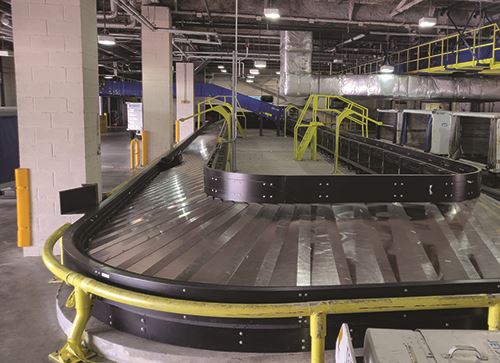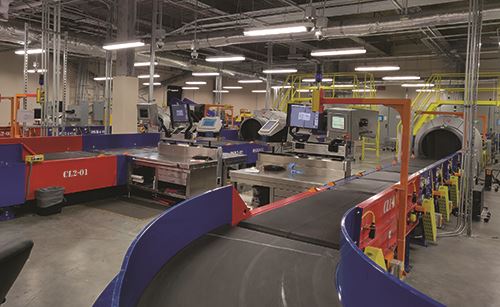Anytime an airport outgrows part of its infrastructure, it’s challenging to keep operations running smoothly. When that component is the outbound baggage handling system, it can cause a cascade of other operational inefficiencies.
Anytime an airport outgrows part of its infrastructure, it’s challenging to keep operations running smoothly. When that component is the outbound baggage handling system, it can cause a cascade of other operational inefficiencies.
When luggage doesn’t get loaded on time, it stresses bag screeners, operations personnel, airfield crews, airline partners, customer service agents and, ultimately, passengers.
Savannah/Hilton Head International Airport (SAV) lived this difficult industry reality during consecutive years of substantial growth in passenger volume. Eventually, it became untenable for the Georgia airport to cope with an outbound baggage handling system that was less-than-ideal from the start.
|
facts&figures Project: New Outbound Baggage Handling System Location: Savannah/Hilton Head Int’l Airport
2018 Traffic: Nearly 1.4 million enplanements
Project Cost: $6.7 million for Phase I; $4.3 million Funding: Phase I funded with passenger facility charges; Phase II funded with TSA grants Architect: RS&H Design Consultant: JSM & Associates Timeline: Phase I completed in 2018; Phase II completed in Aug. 2019 Key Benefits: Increased efficiency; enhanced automation; colocation of business entities; improved work environment Accolade: 2019 Commercial Service Airport Project of the Year by the Georgia Airports Association |
Fortunately, conditions have improved dramatically for SAV, its workers and customers. The airport completely replaced its former single-pier baggage handling system in a two-phase $11 million project. The first phase, launched in 2015 and completed in 2018, consolidated and centralized the TSA baggage screening checkpoint. The second phase, which automated the newly installed system to make it even more efficient, launched in 2018 and was completed in August 2019.
Mark Denmark, assistant director of Engineering for SAV, reports that Phase I cost $6.7 million and was paid for with passenger facility charges; Phase II cost $4.3 million and was largely funded by TSA grants.
A study by RS&H, an architectural, engineering and consulting firm with a full-service aviation practice, provided direction for both phases.
Passenger Growth Spurs
Updates
Like other U.S. airports, SAV faced formidable changes and challenges after 9/11. The growing airport had limited space at its disposal when the newly formed TSA scrambled to implement stricter, more uniform security screening processes. As a result, the checked bag screening system installed at SAV proved to be rather cumbersome: Each airline inducted luggage at the ticketing area and the items were transported to decentralized screening locations in the bag make-up areas via bag tug carts. After bags were screened, they were loaded back onto carts and towed back to be sorted by airline personnel for loading onto airplanes—a manual and inefficient process.
“The TSA screening area was sheltered, but there was no air conditioning,” explains Keith Nix, a senior engineer with RS&H and project manager for the baggage systems upgrades at SAV. “Not only could it get very hot in there, but workers also had to contend with the exhaust fumes from all the tug cart vehicles driving through. It wasn’t the best environment, and the process was extremely inefficient.”
Rapid growth in passenger volume further complicated the already difficult situation. Year after year, SAV’s enplanements increased by double-digit percentages. Feeling the strains, airport officials commissioned a third-party study in 2014. The resulting report confirmed the need to replace the existing baggage handling system with something more efficient.

The airport performed its due diligence by visiting other similar airports to survey their systems, and SAV ultimately modeled its screening system after the one that had been recently installed at Piedmont Triad International in Greensboro, NC.
 “They knew they wanted a centralized screening facility that was isolated and climate-controlled,” Nix explains. “They also knew they wanted to have a common system that would collect all the bags from all of the ticket counters and route it to a central point.”
“They knew they wanted a centralized screening facility that was isolated and climate-controlled,” Nix explains. “They also knew they wanted to have a common system that would collect all the bags from all of the ticket counters and route it to a central point.”
Together, the changes would enhance conditions for workers and improve the handling process by eliminating the need to cart baggage back and forth for screening.
Although the RS&H study made it clear that a new system was needed, TSA funding for the project was not available. With passenger volumes continuing to rise, the airport could not wait any longer and designated passenger facility charge funds to pay for the project. Construction on Phase I began in 2016 and was completed in 2018.

The new centralized TSA screening area was created in space that once housed kitchen equipment and other items for airport concessionaires, but was no longer being used. Although the project required minimal new construction, extensive renovations were needed to carve a path for the luggage conveyor belts that now serve the airport’s north and south wings. “Anytime you’re trying to route a complex baggage handling system through an existing building structure, that in itself is a challenge,” Nix comments.
As the baggage handling system design consultant, JSM & Associates provided conceptual and schematic design concepts, construction documents and construction administration services for the project. Later, it provided testing and commissioning support. “Getting the bags downstairs while maintaining specific rights of way, design criteria and keeping the airport operational was a challenge,” says Brian Shomock, vice president of operations for JSM. For instance, large structural cross braces that could not be removed limited path options for the new conveyor belt system. “That’s the nature of construction, right? You just have to work through that and design around issues. It was nothing that was heart-stopping,” he states.
Fortunate Latitude
 Installing the new baggage system while passengers continued to stream through the airport was also tricky. But it was a challenge that RS&H and JSM had both experienced before. Their plan to phase-in the new system took advantage of a vacant counter in the ticketing area. As the project team shut down each airline’s baggage conveyor belt for modifications, the spare belt at the vacant counter was pressed back into service. “Our Operations staff did a tremendous job keeping track of those bags and moving them to the right locations when they got down to the lower level,” Denmark reports.
Installing the new baggage system while passengers continued to stream through the airport was also tricky. But it was a challenge that RS&H and JSM had both experienced before. Their plan to phase-in the new system took advantage of a vacant counter in the ticketing area. As the project team shut down each airline’s baggage conveyor belt for modifications, the spare belt at the vacant counter was pressed back into service. “Our Operations staff did a tremendous job keeping track of those bags and moving them to the right locations when they got down to the lower level,” Denmark reports.
Before Phase I was completely finished, crews began on Phase II. Automation was added to the new baggage handling system to eliminate work that was still being performed manually. This reduced the potential for handling mistakes and provided a more ergonomic and efficient operation, notes Shomock.
The fully automated system, known as a mini inline system, is among the last of its type to be approved by TSA, says Nix. The agency, which had been using three explosives detection system machines at SAV, added a fourth as part of Phase II.
 “We changed it from stem to stern—from a decentralized, manually intensive operation to a modified standalone system finishing with a fully integrated mini inline system,” Shomock reflects.
“We changed it from stem to stern—from a decentralized, manually intensive operation to a modified standalone system finishing with a fully integrated mini inline system,” Shomock reflects.
The sweeping improvements were immediately leveraged and appreciated. In 2018, SAV handled nearly 2.8 million commercial passengers—a 13.4% increase over 2017 and an all-time record for the airport. With all signs pointing to continued growth, airport management and frontline employees are relieved to have a baggage handling system that is ready to handle it.



